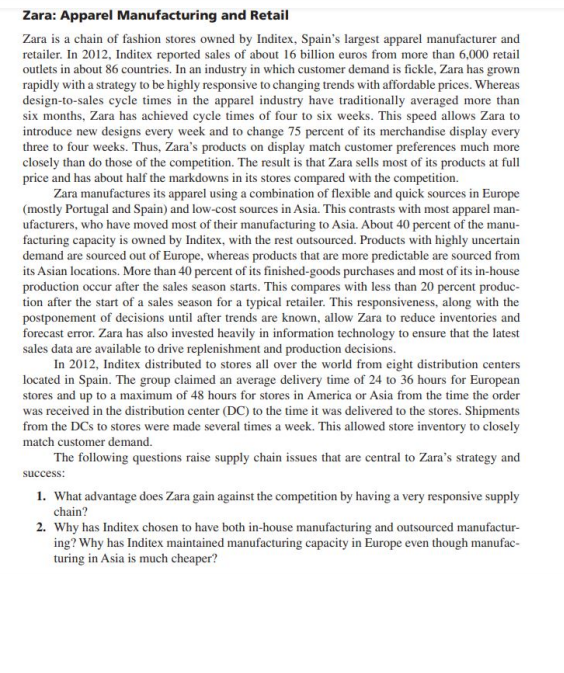Zara is a chain of fashion stores owned by Inditex, Spain's largest apparel manufacturer and retailer. In 2012, Inditex reported sales of about 16 billion euros from more than 6,000 retail outlets in about 86 countries. In an industry in which customer demand is fickle, Zara has rapidly with a strategy to be highly responsive to changing trends with affordable prices. Whereas design-to-sales cycle times in the apparel industry have traditionally averaged more than six months, Zara has achieved cycle times of four to six weeks. This speed allows Zara to introduce new designs every week and to change 75 percent of its merchandise display every three to four weeks. Thus, Zara's products on display match customer preferences much more closely than do those of the competition. The result is that Zara sells most of its products at full price and has about half the markdowns in its stores compared with the competition. Zara manufactures its apparel using a combination of flexible and quick sources in Europe (mostly Portugal and Spain) and low-cost sources in Asia. This contrasts with most apparel man- ufacturers, who have moved most of their manufacturing to Asia. About 40 percent of the manu- facturing capacity is owned by Inditex, with the rest outsourced. Products with highly uncertain demand are sourced out of Europe, whereas products that are more predictable are sourced from its Asian locations. More than 40 percent of its finished-goods purchases and most of its in-house production occur after the sales season starts. This compares with less than 20 percent produc- tion after the start of a sales season for a typical retailer. This responsiveness, along with the postponement of decisions until after trends are known, allow Zara to reduce inventories and forecast error. Zara has also invested heavily in information technology to ensure that the latest sales data are available to drive replenishment and production decisions. In 2012, Inditex distributed to stores all over the world from eight distribution centers located in Spain. The group claimed an average delivery time of 24 to 36 hours for European stores and up to a maximum of 48 hours for stores in America or Asia from the time the order was received in the distribution center (DC) to the time it was delivered to the stores. Shipments from the DCs to stores were made several times a week. This allowed store inventory to closely match customer demand. grown The following questions raise supply chain issues that are central to Zara's strategy and success: 1. What advantage does Zara gain against the competition by having a very responsive supply chain? 2. Why has Inditex chosen to have both in-house manufacturing and outsourced manufactur- ing? Why has Inditex maintained manufacturing capacity in Europe even though manufac- turing in Asia is much cheaper?
Critical Path Method
The critical path is the longest succession of tasks that has to be successfully completed to conclude a project entirely. The tasks involved in the sequence are called critical activities, as any task getting delayed will result in the whole project getting delayed. To determine the time duration of a project, the critical path has to be identified. The critical path method or CPM is used by project managers to evaluate the least amount of time required to finish each task with the least amount of delay.
Cost Analysis
The entire idea of cost of production or definition of production cost is applied corresponding or we can say that it is related to investment or money cost. Money cost or investment refers to any money expenditure which the firm or supplier or producer undertakes in purchasing or hiring factor of production or factor services.
Inventory Management
Inventory management is the process or system of handling all the goods that an organization owns. In simpler terms, inventory management deals with how a company orders, stores, and uses its goods.
Project Management
Project Management is all about management and optimum utilization of the resources in the best possible manner to develop the software as per the requirement of the client. Here the Project refers to the development of software to meet the end objective of the client by providing the required product or service within a specified Period of time and ensuring high quality. This can be done by managing all the available resources. In short, it can be defined as an application of knowledge, skills, tools, and techniques to meet the objective of the Project. It is the duty of a Project Manager to achieve the objective of the Project as per the specifications given by the client.


Trending now
This is a popular solution!
Step by step
Solved in 2 steps

